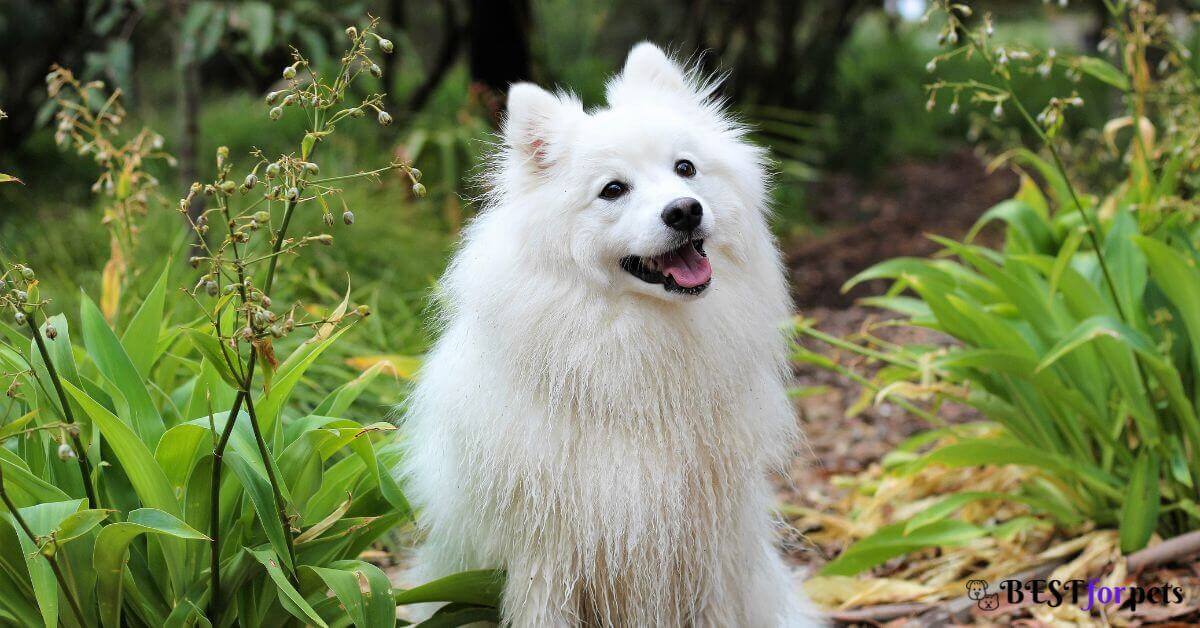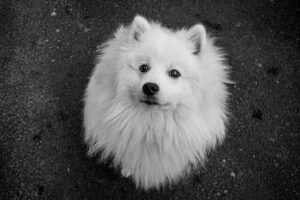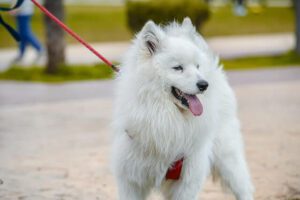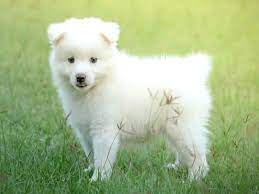Are you looking for a dog breed that is not only intelligent and apartment-friendly but also has an unusually expressive face? Look no further than the Indian Spitz! Descended from the German Spitzes and introduced to India by the occupying British during the 19th century, these dogs have become one of the top 15 popular breeds in their homeland. With their soft chest, fair tail, and milky white double coat, Indian Spitzes are not only beautiful but also super friendly, playful, and easily trainable.
They make excellent watchdogs and get along well with everyone in the family, including kids and other pets. But there’s so much more to know about this fascinating breed! In this article, we’ll provide a complete dog breed profile, including temperament, lifespan, price, and more. Whether you’re a new owner or an experienced dog owner, you won’t want to miss this guide to everything you need to know about the Indian Spitz.
Origins of the Indian Spitz Dog
The Indian Spitz dog breed is said to have originated in the 19th century when the Britishers ruling India introduced them by breeding them from German Spitzes. The breed was developed to cope with the heat of Indian summers and retained the intelligence and adaptability of the German breed.
Although the Indian Spitz is often mistaken for the Pomeranian breed, they are not related. The Indian Spitz is a captivating dog breed that is native to India. It became popular in the 1980s and 1990s when import restrictions made it difficult to bring in foreign breeds.
The Indian Spitz is a small to medium-sized dog that is known for its fluffy white fur and fox-like appearance. They are intelligent, active, and playful dogs that make great companions for families with children.
Overall, the Indian Spitz is a unique breed that has captured the hearts of many dog lovers in India and around the world. With their interesting history and charming personality, they continue to be a popular choice for pet owners looking for a loyal and affectionate companion.
Physical Characteristics of the Indian Spitz Dog
Size and Weight
The Indian Spitz is a small-sized dog breed, usually measuring around 35-45 cm in height at the shoulder. They weigh between 15-20 kg (11-45 pounds), with males being larger than females. The breed has a square-shaped body, with a soft chest, fair tail, and a milky white double coat.
Coat and Colors
The Indian Spitz has a thick, dense coat that protects them from harsh weather conditions. Their coat is soft and fluffy, and it comes in various colors such as white, black, brown, and golden. The coat is usually longer around the neck, chest, and tail, giving them a lion-like appearance.
Eyes and Ears
The Indian Spitz has a pair of small, almond-shaped eyes that are usually blue or green. Their eyes have visible irises that give them an unusually expressive face. They have pointy, fox-like ears set high up on their head, which are covered with fur.
In summary, the Indian Spitz is a small-sized dog breed with a soft chest, fair tail, and a milky white double coat. They come in various colors such as white, black, brown, and golden. They have a pair of small, almond-shaped eyes that are usually blue or green in color and pointy, fox-like ears set high up on their head.
Temperament and Personality Traits
The Indian Spitz is known for its friendly and playful nature, making it an ideal family pet. They are highly adaptable and thrive in warm, humid climates. These dogs are also excellent watchdogs, always alert and protective of their family.
Indian Spitz dogs are highly intelligent and eager to please their owners, making them easy to train. They are also highly social and enjoy being around people. However, they can be independent and bold at times, which may not be suitable for novice owners.
These dogs have a working background and are known for their loyalty and affection towards their family. They require regular exercise and mental stimulation to keep them happy and healthy. A lack of proper exercise and attention can lead to destructive behavior and excessive barking.
Overall, the Indian Spitz is a confident and lively dog that makes a great companion for those who are willing to put in the time and effort to train and care for them properly.
Health and Lifespan
Common Health Issues
Like any other breed, the Indian Spitz can be susceptible to certain health issues. Some of the common health issues that Indian Spitz dogs may develop are:
- Hip Dysplasia
- Eye problems like cataracts and progressive retinal atrophy
- Skin allergies
- Dental problems like tartar buildup and gum disease
- Obesity
It is important to take your Indian Spitz for regular check-ups to ensure that they are in good health. Early detection of health issues can help prevent them from becoming more serious.
Average Lifespan
The average lifespan of an Indian Spitz is between 10 to 14 years. However, with proper care and regular exercise, they can live longer. Indian Spitz dogs are generally healthy and have a good immune system. It is important to provide them with a healthy diet, regular exercise, and proper grooming to ensure they live a long and healthy life.
In conclusion, while Indian Spitz dogs are generally healthy, they can still develop health issues. Regular check-ups and proper care can help prevent health issues from becoming more serious. With proper care, an Indian Spitz can live a long and healthy life.
Diet and Nutrition
Indian Spitz dogs require a balanced and nutritious diet to maintain their health and well-being. A well-balanced diet should consist of proteins, carbohydrates, healthy fats, vitamins, and minerals.
Proteins are essential for building and repairing muscles and tissues. Indian Spitz dogs should consume 25% of their diet in the form of proteins. Good sources of protein include chicken, fish, beef, and lamb.
Carbohydrates provide energy to the body. Indian Spitz dogs should consume carbohydrates in the form of grains such as rice and wheat.
Healthy fats are essential for maintaining a healthy immune system and nervous system. Indian Spitz dogs can consume healthy fats in the form of fish oil, flax seed oil, and olive oil.
Calcium is necessary for building strong bones and teeth. Indian Spitz dogs can obtain calcium from dairy products such as cheese and yogurt.
Vitamins are essential for maintaining overall health. Indian Spitz dogs can obtain vitamins from fruits and vegetables.
It is important to avoid feeding Indian Spitz dogs table scraps as it can lead to obesity and other health issues. Treats should be given in moderation and should not exceed 10% of their daily nutrition. Freshwater should be available at all times.
Overall, a well-balanced diet and proper nutrition are essential for keeping Indian Spitz dogs healthy and happy.
Exercise and Activity Levels
The Indian Spitz is an energetic dog breed that requires daily exercise to maintain good health and prevent boredom. They are highly active and enjoy running, playing, and exploring their surroundings.
On average, an Indian Spitz needs at least 30 minutes of exercise per day. This can be in the form of a brisk walk, playtime in the backyard, or a game of fetch. They also enjoy participating in dog sports such as agility and obedience training.
It is important to note that Indian Spitz dogs are not suited for intense workouts or jogging. They have a moderate activity level and prefer a variation between fast and slow walking. Overexertion can lead to injury or exhaustion, so it is important to monitor their activity levels and adjust accordingly.
In addition to physical exercise, mental stimulation is also important for Indian Spitz dogs. They are intelligent and curious and require mental challenges to prevent boredom and destructive behavior. Interactive toys, puzzle games, and training sessions can provide mental stimulation and improve their overall well-being.
Overall, the Indian Spitz is an active breed that requires daily exercise and mental stimulation to maintain good health and happiness. A well-exercised and mentally stimulated Indian Spitz will be a happy and well-behaved companion.
Training the Indian Spitz Dog
Indian Spitz dogs are intelligent and trainable, but they can also have unpredictable behavior. Therefore, it is essential to provide them with adequate training to ensure they become obedient and well-behaved pets. Here are some tips for training an Indian Spitz:
Positive Reinforcement
Indian Spitz dogs respond well to positive reinforcement training. This type of training involves rewarding the dog for good behavior, such as sitting or staying on command. Rewards can include treats, toys, or praise. Punishing the dog for bad behavior is not recommended, as it can lead to fear and anxiety.
Consistency
Consistency is key when training an Indian Spitz. It is important to use the same commands and rewards every time to avoid confusion. Training sessions should be short and frequent, with a maximum of 10-15 minutes per session.
Socialization
Socialization is crucial for Indian Spitz dogs. They need to be exposed to different people, animals, and environments from a young age to prevent them from becoming fearful or aggressive. Taking them to puppy classes or dog parks can help with socialization.
Mental and Physical Stimulation
Indian Spitz dogs are intelligent and active, and they require both mental and physical stimulation to stay happy and healthy. Providing them with toys, puzzles, and games can help stimulate their minds, while daily walks or runs can help keep them physically fit.
Obedience Training
Obedience training is essential for Indian Spitz dogs, as it helps them learn basic commands and manners. Commands such as sit, stay, come, and heel should be taught using positive reinforcement techniques. It is also important to teach them to walk on a leash and to come when called.
Overall, Indian Spitz dogs are intelligent and trainable, but they require consistent training and socialization to become well-behaved pets. Positive reinforcement, consistency, socialization, mental and physical stimulation, and obedience training are all important aspects of training an Indian Spitz.
Grooming Needs
The Indian Spitz is a low-maintenance breed when it comes to grooming. However, they tend to shed often, so regular brushing is necessary to prevent their fur from getting all over the house. The following are some tips and guidelines for grooming an Indian Spitz:
- Brushing: Regular brushing is required to keep their coat healthy and shiny. Brushing at least twice a week is recommended, and during shedding seasons, more frequent brushing is necessary to control hair fall.
- Bathing: Occasional baths are necessary to keep them clean and smelling fresh. However, over-bathing can strip their coat of natural oils and cause skin irritation. It is recommended to bathe them once every two months or as needed.
- Nail Trimming: Regular nail trimming is necessary to prevent overgrowth, which can cause discomfort and pain. It is recommended to trim their nails once every two weeks or as needed.
- Ear Cleaning: Regular ear cleaning is necessary to prevent ear infections. It is recommended to clean their ears once a week using a cotton ball or a soft cloth dampened with an ear-cleaning solution.
- Dental Care: Regular dental care is necessary to prevent dental problems such as tartar buildup, gum disease, and bad breath. It is recommended to brush their teeth once a week using a dog toothbrush and toothpaste.
Overall, the Indian Spitz is a relatively easy breed to groom. Regular brushing, occasional bathing, proper nail trimming, ear cleaning, and dental care are all that are needed to keep them healthy and happy.
Indian Spitz Dog and Families
The Indian Spitz is a highly adaptable breed that makes an ideal family dog. They are friendly, playful, and easily trainable, which makes them an excellent choice for households with children and other pets.
Compatibility with Children
Indian Spitz dogs are known for their affectionate and playful nature, which makes them great companions for children. They have a high energy level and love to play, which means they can keep up with even the most active kids. However, it is important to supervise interactions between children and dogs to ensure that both parties are safe.
Compatibility with Other Pets
The Indian Spitz is a social breed that gets along well with other pets, including cats and other dogs. They are not known for being aggressive or territorial, which makes them an excellent choice for households with multiple pets. However, it is important to introduce new pets to the Indian Spitz gradually to avoid any potential conflicts.
In summary, the Indian Spitz is a great family dog that is highly adaptable and gets along well with both children and other pets. With proper training and socialization, they can make a wonderful addition to any household.
Spitz Dog Price In India
Spitz dog prices in India can range from Rs. 3,000 to Rs. 12,000. Due to high demand spitz puppy price is higher than grown-up spitz.
Factors Influencing Spitz Price in India
Breed Quality: The price of Spitz dogs in India largely depends on their breed quality. High-quality pedigrees, which adhere to breed standards and come from reputable breeders, often command a premium price due to their superior lineage and characteristics.
Bloodline and Pedigree: Dogs with well-documented pedigrees and champion bloodlines tend to be more expensive. The lineage not only impacts physical traits but also gives potential buyers insight into the dog’s health history and temperament.
Age of the Dog: The age of the Spitz dog can influence its price. Puppies are typically more expensive than older dogs, as they are in high demand and can be trained to adapt to their new environment more easily.
Coat Color and Markings: Specific coat colors and markings, such as rare or unusual patterns, can also affect the price of a Spitz. Certain colors or patterns may be more desirable among buyers, leading to higher price tags.
Location and Breeder Reputation: The location of the breeder and their reputation play a vital role in determining the Spitz’s price. Breeders with a strong track record of producing healthy and well-socialized dogs may charge a premium. You can find reputed breeders at The kennel Club of India
Vaccinations and Health Check-ups: Responsible breeders ensure that their Spitz puppies are vaccinated and have undergone necessary health check-ups, which can influence the overall cost of the dog.
Market Demand and Availability: Like any other commodity, the price of Spitz dogs can fluctuate based on market demand and availability. Factors such as trends, celebrity endorsements, and cultural influences can also impact prices.
Frequently Asked Questions
Q. Are Indian Spitz dogs good with children?
A. Yes, Indian Spitz dogs are generally good with children. They are playful and energetic, making them great companions for kids. However, as with any breed, it is important to supervise interactions between children and dogs to ensure safety.
Q. What is the average lifespan of an Indian Spitz dog?
A. The average lifespan of an Indian Spitz dog is around 12-14 years. With proper care and nutrition, they can live even longer.
Q. How much exercise does an Indian Spitz dog require?
A. Indian Spitz dogs are active and require daily exercise. A walk or run for 30-45 minutes per day should be sufficient to keep them healthy and happy.
Q. What is the temperament of an Indian Spitz dog?
A. Indian Spitz dogs are known for their intelligence, loyalty, and playfulness. They are also vocal and can be protective of their family. Early socialization and training can help to ensure a well-behaved and well-adjusted dog.
Q. Do Indian Spitz dogs shed a lot?
A. Yes, Indian Spitz dogs do shed a lot. Regular brushing and grooming can help to minimize shedding and keep their coat healthy.
Q. What are the grooming requirements for an Indian Spitz dog?
A. Indian Spitz dogs have a thick double coat that requires regular grooming. They should be brushed at least once a week to prevent matting and tangling. Bathing should be done as needed, but not too frequently as it can strip their coat of natural oils.
You may also like





9 thoughts on “Indian Spitz Dog in: Characteristics, Temperament, and Care”